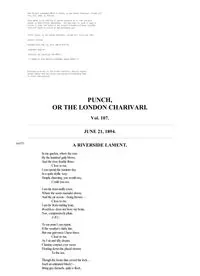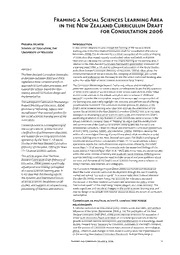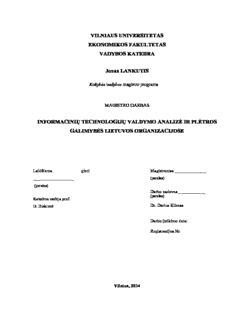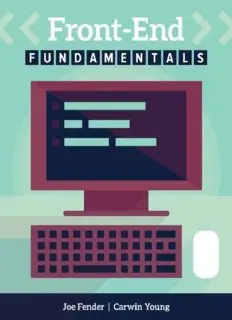
Front-End Fundamentals: A practical guide to front-end web development. PDF
Preview Front-End Fundamentals: A practical guide to front-end web development.
Front-End Fundamentals A practical guide to front-end web development. Joe Fender and Carwin Young This book is for sale at http://leanpub.com/front-end-fundamentals This version was published on 2015-02-11 * * * * * This is a Leanpub book. Leanpub empowers authors and publishers with the Lean Publishing process. Lean Publishing is the act of publishing an in-progress ebook using lightweight tools and many iterations to get reader feedback, pivot until you have the right book and build traction once you do. * * * * * © 2014 - 2015 Joe Fender and Carwin Young Thanks to, Sally Rose, Carrie Young and Justin Harrell Table of Contents About the Authors Joe Fender Carwin Young Introduction Who This Book Is For An Overview of This Book Example Code Contacting the Authors Getting Started Expectations of a Front-End Developer Setting Up Your Local Environment Frameworks Model-View-Whatever Architecture Single-Page Applications AngularJS Backbone.js Ember Summary Styling Responsive Web Design Authoring Methodologies Preprocessors Performance and CSS Styling Summary Dependency Management What is a Package Manager? Node.js and the Node Package Manager (npm) Bower Bundler Documentation Summary Automation Task Runners Grunt Gulp CodeKit Yeoman Other Tips Summary Summary Appendix Accessibility Automation Deployment Learning Resources Frameworks Languages Online Services Package Managers Performance Software Styling Templating Testing Version Control Web Servers About the Authors Joe and Carwin started working together in 2013 at Lullabot, an interactive strategy, design and development company. At Lullabot, they work with decision makers, developers, and designers at all stages of a web project. They have guided the development of sites for clients such as Martha Stewart, The GRAMMYs, MTV UK, Sony Music, Lifetime Television, The George Lucas Educational Foundation, Leo Laporte’s TWiT network, and many others. Joe Fender Joe Fender lives in London, UK and splits his focus between front-end and back-end development. Specializing in PHP, AngularJS and Drupal, Joe was the lead architect at Studio Umi, the largest Drupal shop in Japan before joining Lullabot to work on awesome websites such as Drupalize.Me and MSNBC. In his spare time, Joe likes to collect shoes and work on side projects. But never at the same time. Carwin Young Carwin Young is an expert front-end developer living in Springfield, Missouri. He has over 8 years experience working on the front-end. He was the second front-end developer to work at Lullabot where he has played a key role on building websites for clients such as MSNBC, BravoTV and the GRAMMYs. Carwin loves to share his expertise. He has spoken on topics such as Rapid Drupal Development at DrupalCamp Chicago, is a co-organizer for the Springfield Drupal meet- up and is a regular contributor to the Front-end Rapport, an online magazine for front-end developers. Introduction Front-end web development is evolving. Long gone are the days of writing static HTML files with self-contained CSS. As web developers in this modern world, we need to understand and utilize an endless number of frameworks, plugins, techniques and more. Knowing the right tools to use and when to use them is key to building successful solutions. Despite our best efforts, it can be difficult to keep up with the speed of advancing web development. We sure as hell can’t slow it down. And why would we want to? It’s so exciting to not know where technology is headed and what could be around the next corner. We should both prepare for change and embrace it. And that is exactly where front-end developers excel. We build what the consumer sees and because of that, we want to use the most cutting-edge technologies to create the biggest impact. This book came to be from the lessons we, the authors, have learnt through trial and error whilst working on front-end development projects ranging from enormous high-traffic sites such as MSNBC, The GRAMMYs and BravoTV to startups and experiments such as Drupalize.Me and BracketCloud. We want to share with you the tools that we use and the standards that we follow. Our ultimate goal is for you to walk away understanding the core concepts of front-end development so you can confidently go and work on your own projects. This book is somewhat opinionated based on our experience, so you’ll find some of the content heavily geared towards a particular way of doing things. Of course, there are many ways of accomplishing the same task in the world of front-end development; that’s what makes it so accessible and yet so complicated. Learning one way of doing something can make learning the alternatives a much more palatable task, so we encourage you to look into any and all of the technologies presented herein and even go on to see if something else might better fit your needs. Who This Book Is For The content in this book is aimed at those who are new to front-end web development. Regardless of whether you are a beginner or expert developer, the concepts outlined in this book are essential to embracing the rapidly evolving web. We won’t be covering the general basics of web development so you will most likely want to get up to speed on the fundamentals of web programming such as HTML, CSS and JavaScript. We will also be utilizing the command line, so some basic knowledge of how to use that on your operating system is recommended. If you hear yourself asking any of the following questions, this book will likely be very useful for you! “What actually is front-end development?” “How can I be a more efficient web developer?” “What is Grunt/AngularJS/SASS/<insert popular tool name here>?” “How do I fit all of these front-end tools together into a project?” “How can I build a front-end application that can scale?” An Overview of This Book Every web project that you work on is different and there is no ‘one size fits all’ set of tools. However, throughout the chapters in this book, we’ll introduce you to some of the most popular, useful and powerful tools used in front-end web development so that when you’re done reading you will be able to apply the concepts and techniques to whatever you are working on. 1. Getting Started The aim of the first chapter of this book is to help get you acclimated with front-end development in general. You’ll learn what’s expected from a front-end developer and get a short overview of the types of projects a front-end developer might be tasked with. We’ll even take you through setting up your computer for local development. 2. Frameworks This chapter jumps right into some of the more popular JavaScript frameworks and template languages in use today. We’ll cover the details of what exactly a ‘framework’ is and talk about the MVC pattern before getting into the details of installation and practical usage of 3 popular frameworks: AngularJS, Backbone.js and Ember.js. 3. Styling There’s a lot more to styling than just throwing CSS at your markup; that just leads to a big mess of unreadable spaghetti code sprinkled with !important parmesan. Here we’ll cover CSS preprocessors like Sass, organizational methods for your styles, and the kind of impact your CSS may have on a project’s performance. 4. Dependency Management Getting your whole team on the same page code-wise can be challenging. Heck, even making sure you’re using the same version of that awesome Ruby gem after an update can be a pain. This chapter on dependency management covers a number of really handy front-end package managers like npm, Bower, and Bundler. You’ll learn what a package manager is and how to use it effectively to keep your project on track. 5. Automation Do you like doing the same repetitive tasks over and over? No? Neither do we. The automation chapter is about just that, automation. We’ll go over how you can remove the tedium from front-end development and just get to work. In this chapter you’ll learn how to perform tasks like checking your JavaScript or CSS for errors whenever you save a file, minify your code to shave off some file size, and even how to automatically refresh your browser whenever something changes. Once you get started, you’ll never look back. Example Code This book contains many code snippets for demonstration purposes. Code may appear differently depending on the device you are using to read this book. Here is an example of a code snippet so you know what to expect: 1 var gulp = require('gulp'), 2 uglify = require('gulp-uglify'); 3 4 // This task uglifies our JS files. 5 gulp.task('compress', function() { 6 gulp.src('src/js/*.js') 7 .pipe(uglify()) 8 .pipe(gulp.dest('dist')) 9 }); You will also notice that we reference code inline like this throughout the book. Contacting the Authors If you have any feedback or questions, please feel free to contact us via the Front-End Fundamentals Google Group. You can either create a new topic via the web interface or you can send an email to the mailing list address: front-end-fundamentals@googlegroups.com We will do our best to consider each and every new message received. Please understand that depending on the volume of requests, it may be difficult for us to respond immediately.
The list of books you might like

Shatter Me Complete Collection (Shatter Me; Destroy Me; Unravel Me; Fracture Me; Ignite Me)

Credence

Corrupt (Devil's Night #1)

As Good as Dead

TS 125 307 - V5.5.0 - Universal Mobile Telecommunications System (UMTS); Requirements on User Equipments (Ues) supporting a release-independent frequency band (3GPP TS 25.307 version 5.5.0 Release 5)

CARACTERIZACIÓN ANATÓMICA CUALITATIVA DE LOS EJES CAULINARES EN LAS ...

car-part ii - chapter 2 flight crew licensing car-fcl
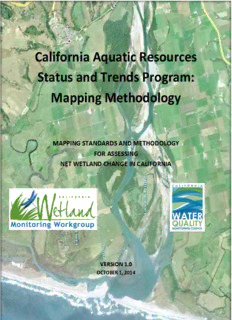
California Aquatic Resources Status and Trends Program: Mapping Methodology

Polar Bear: 2006

Glossary
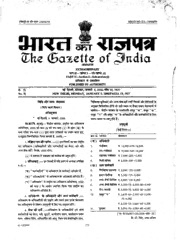
Extraordinary Gazette of India, 2006, No. 518
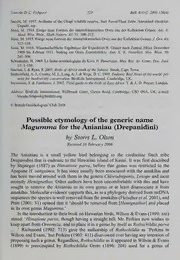
Possible etymology of the generic name Magumma for the Anianiau (Drepanidini)
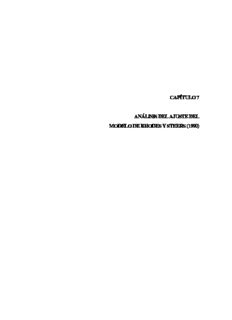
capítulo 7 análisis del ajuste del modelo de rhodes y steers (1990)

the greek banking case
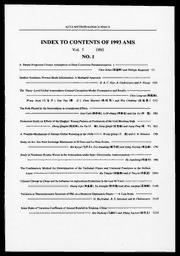
Acta Meteorologica Sinica 1993: Vol 7 Index & Table of Contents
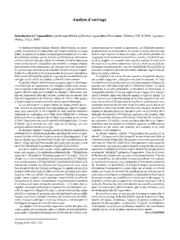
Introduction à l’Aquaculture, par Roland Billard

Taal en AKA - Steunpunt taal en rekenen mbo
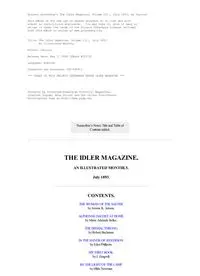
The Idler Magazine An Illustrated Monthly July 1893

Making Liberia Safe: Transformation of the National Security Sector
